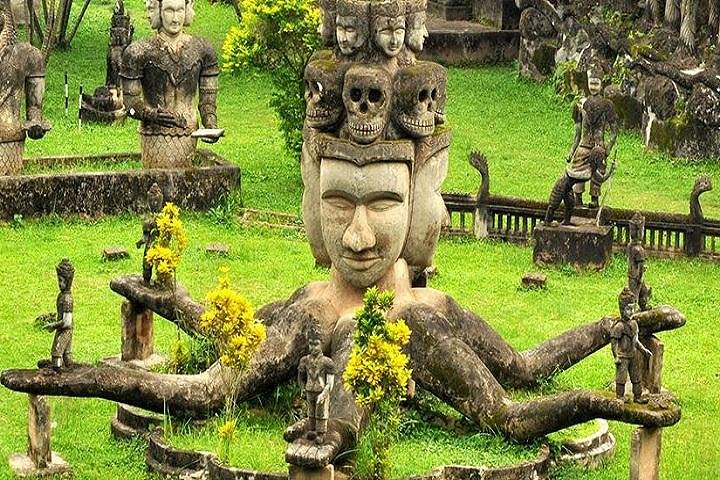Exploring the Spiritual and Culinary Wonders of Vientiane
Embark on a cultural journey through Vientiane with a visit to the enchanting Buddha Park and a vibrant evening food tour. Discover the spiritual and culinary delights that make this city a unique blend of tradition and modernity.
A Journey Through Time at Buddha Park
As I embarked on the Buddha Park and Food Tour, I was filled with anticipation. The journey began with a comfortable ride to Buddha Park, located 25 kilometers southeast of Vientiane. This open-air sculpture park, also known as Xieng Khuan, is a mesmerizing blend of Buddhist and Hindu influences. Founded in 1958 by the visionary monk and sculpture artist Bunleua Sulila, the park is a testament to his unique vision of spiritual harmony.
Walking through the park, I was captivated by the giant sculptures of Buddha and Hindu deities. Each statue seemed to tell a story, a silent narrative of faith and devotion. The intricate details and the sheer scale of the sculptures were awe-inspiring. It was a place where time seemed to stand still, allowing me to reflect on the rich tapestry of beliefs that have shaped this region.
The park was not just a visual feast but a spiritual journey. As someone who has always been fascinated by the intersection of different cultures and religions, I found Buddha Park to be a profound experience. It was a reminder of the shared human quest for meaning and connection, transcending geographical and cultural boundaries.
A Culinary Adventure at the Morning Market
After the serene experience at Buddha Park, the tour took a vibrant turn as we headed to the bustling morning market. The market was a sensory overload in the best possible way. The air was filled with the aroma of fresh produce, spices, and street food. It was a lively tapestry of colors, sounds, and smells, each stall offering a glimpse into the local way of life.
Our guide, a local with an infectious enthusiasm for his culture, introduced us to the various ingredients and delicacies that are staples in Laotian cuisine. From exotic fruits to fresh herbs, the market was a treasure trove of culinary delights. I was particularly fascinated by the array of fish, poultry, and meats, each presented with care and pride.
As we wandered through the market, I couldn’t help but draw parallels to the markets I had visited in Japan. The emphasis on freshness, the meticulous presentation, and the deep respect for food were common threads that connected these seemingly disparate cultures. It was a reminder of the universal language of food, a language that speaks of tradition, community, and sustenance.
Savoring Local Flavors Near the Great Sacred Stupa
The final leg of the tour was a culinary exploration near the Great Sacred Stupa, or Pha That Luang. Here, we were treated to an array of local street food, each dish a testament to the rich culinary heritage of Laos. From savory skewers to sweet treats, the flavors were bold and authentic, a true reflection of the local palate.
Eating like a local was an experience in itself. The street food stalls were bustling with activity, each vendor eager to share their culinary creations. It was a communal experience, a chance to connect with the locals and share in their love for food.
As I savored each bite, I was reminded of the meals I had shared with my family, a blend of Japanese and American flavors that spoke of my own multicultural heritage. It was a fitting end to a day that had been a celebration of culture, tradition, and the simple joys of life.
The Buddha Park and Food Tour was more than just a tour; it was a journey into the heart of Laos, a chance to immerse myself in its rich cultural tapestry. It was a reminder of the beauty of diversity and the connections that bind us all, regardless of where we come from.








































